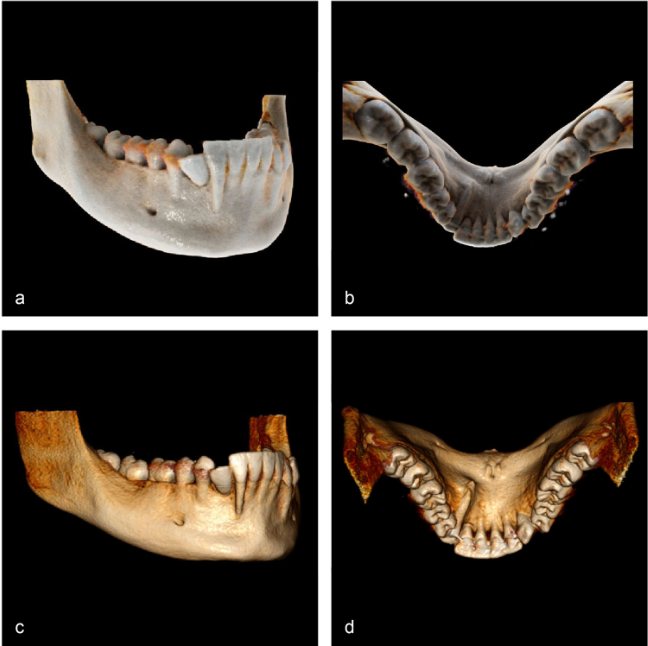An interesting article titled “Three-dimensional perception of cinematic rendering versus conventional volume rendering using CT and CBCT data of the facial skeleton,” written by Tobias Steffen and et al. appears in the April 2022 edition of the Annals of Anatomy (151905). The article sought to explore if three-dimensional cinematic rendering image re-constructions offer advantages over conventional volume rendering to visualize cone beam computed tomography (CBCT) and computed tomography (CT) images of the facial skeleton.
In the study, ten dentists reviewed 10 different patient cases of CT or CBCT exams of reconstructed cinematic rendering or volume rendering of the orofacial skeleton. The dentists were given a questionnaire to assess objective and subjective criteria of image perception. To assess objective criteria, predefined questions on the visual perception of anatomical image characteristics, were given to the denists. To assess subjective criteria, a visual analogue scale that showed both reconstructions at the same time was used.
To generate the cinematic rendering and volumetric rendering a post procesing occured of the DICOM image data. Cinematic rendering was inspired by techniques
used for the production of computer-animated movies in the movie industry and used prototype software from Siemens Healthineers. Volume rendering was used using standard clinical post-processing software, specifically in this case Impax PACS by Agfa HealthCare. For each of the 10 different patient cases, 360 degree rotatable cinematic rendering and volume rendering reconstructions were performed in steps of 10 to 20 degrees. The dentists viewed the resultant rendering in the JiveX DICOM viewer by Visus Health and viewed using an NEC monitor.
The dentists viewed the reconstructed renderings over three different sessions. The objective questions were asked in sessions 1 and 2 and the subjective questions were asked in session 3. In the objective sessions, the dentists were randomly shown a cinematic-rendered image or a volume-rendered image and asked to fill out a questionnaire by rating image characteristics on a visual analog scale from 0 to 10. In the last session the cinematic and volume renderings were presented at the same time on one monitor and subjective questions were asked such as how realistic do they rate the image shown on a visual analog scale from 0 to 10. Each session consisted of 10 questions and had to be answered in the order they appeared on the screen.

With regards to the correctness of image interpretation the author found no statisically signficant differences between the cinematic rendering and volumetric rendering. Among the cinematic-rendered images, there were 69.5% correct and 30.5% incorrect answers, while in the volumetric-render images there were 65.5% correct and 34.5% incorrect answers. The dentists subjectively rated the cinematic-rendered images higher for nearly all reconstructions. In the subjective ratings the authors found that the dentist visual analog scale scores on three-dimensionality were 8.03 on cinematic versus 6.93 on volumetric, on contrast were 7.05 on cinematic versus 5.60 on volumetric, on positional relationship were 8.22 on cinematic versus 5.78 on volumetric, on photorealism were 7.25 on cinematic versus 6.21 on volumetric, and on depth perception were 6.83 on cinematic versus 5.87 for volumetric.
The authors state:
“In most subjective categories, [cinematic rendering] CR gave higher scores in the [visual analog scale] VAS scale compared to [volumetric rendering] VR. This difference was significant for the visual parameters three-dimensionality, contrast, positional relationship, photo-realism and depth perception.”
The authors noted that the application of cinematic rendering for CT and CBCT of facial skeleton data shows great potential in terms of depth perception and three dimensionality. Volume rendering, on the other hand, may produce sharper images with better contrast. The authors thus see cinematic rendering as an additive tool with volumetric rendering and both techniques could provide helpful visual information for dentists and surgeons. The authors expect that in the future further studies can assess the diagnostic value of 3D rotational CR reconstructions cinematic-rendered images. They also note a potential limitation of their study was the different resolutions of the CTs and CBCTs included.
